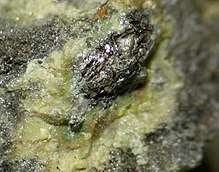Sillénite
| Sillénite | |
|---|---|
 Sillénite from Germany | |
| General | |
| Category | Oxide mineral |
| Formula (repeating unit) | Bi12SiO20 |
| Strunz classification | 4.CB.70 |
| Dana classification | 16a.03.05.01 |
| Crystal system | Cubic |
| Crystal class |
Tetartoidal (23) H-M symbol: (23) |
| Space group | I23 |
| Unit cell | a = 10.110 Å, Z = 2 |
| Identification | |
| Color | Olive-green, gray-green, yellow-green, yellow, reddish-brown |
| Crystal habit | Cubic crystals |
| Mohs scale hardness | 1–2 |
| Luster | Adamantine |
| Diaphaneity | Translucent |
| Specific gravity | 9.16 |
| Optical properties | Isotropic |
| Refractive index | >2.5 |
| Birefringence | none |
| Solubility | Soluble in hydrochloric acid |
| References | [1][2][3] |
Sillénite or sillenite is a mineral with the chemical formula Bi12SiO20. It is named after the Swedish chemist Lars Gunnar Sillén, who mostly studied bismuth-oxygen compounds. It is found in Australia, Europe, China, Japan, Mexico and Mozambique, typically in association with bismutite.[1][2][3]
Sillenites refer to a class of bismuth compounds with a structure similar to Bi12SiO20, whose parent structure is γ-Bi2O3, a meta-stable form of bismuth oxide.[4] The cubic crystal sillenite structure is shared by several synthetic materials including bismuth titanate and bismuth germanate.[5] These compounds have been extensively investigated for their non-linear optical properties.[6][7][8]
Additional stoichiometries, and modified structures, are also found in Bi25GaO39, Bi25FeO39, and Bi25InO39.[9][10] These compounds have gathered recent interest due to their photocatalytic properties.[11]
References
| Wikimedia Commons has media related to Sillénite. |
- 1 2 Sillenite. Webmineral
- 1 2 Sillenite. Mindat
- 1 2 Anthony, John W.; Bideaux, Richard A.; Bladh, Kenneth W.; Nichols, Monte C., eds. (1995). "Sillenite". Handbook of Mineralogy (PDF). II (Silica, Silicates). Chantilly, VA, US: Mineralogical Society of America. ISBN 0962209716.
- ↑ Valant, Matjaz, and Danilo Suvorov. "A stoichiometric model for sillenites." Chemistry of materials 14.8 (2002): 3471-3476 | https://pubs.acs.org/doi/abs/10.1021/cm021173l
- ↑ Santos, D. J.; Barbosa, L. B.; Silva, R. S.; MacEdo, Z. S. (2013). "Fabrication and Electrical Characterization of Translucent Bi12TiiO20 Ceramics". Advances in Condensed Matter Physics. 2013: 1. doi:10.1155/2013/536754.
- ↑ Marinova, Vera, et al. "Real-time holography in ruthenium-doped bismuth sillenite crystals at 1064 nm." Optics letters 36.11 (2011): 1981-1983.
- ↑ Reyher, H-J., U. Hellwig, and O. Thiemann. "Optically detected magnetic resonance of the bismuth-on-metal-site intrinsic defect in photorefractive sillenite crystals." Physical Review B 47.10 (1993): 5638.
- ↑ Malinovskii, Valerii K., et al. "Photoinduced phenomena in sillenites." Novosibirsk Izdatel Nauka (1990).
- ↑ Scurti, Craig A., et al. "Electron diffraction study of the sillenites Bi12SiO20, Bi25FeO39 and Bi25InO39: Evidence of short-range ordering of oxygen-vacancies in the trivalent sillenites." AIP Advances 4.8 (2014): 087125. | https://doi.org/10.1063/1.4893341
- ↑ Arenas, D. J., et al. "Raman spectroscopy evidence of inhomogeneous disorder in the bismuth-oxygen framework of Bi 25 InO 39 and other sillenites." Physical Review B 86.14 (2012): 144116. | https://doi.org/10.1103/PhysRevB.86.144116
- ↑ Lopes, Armandina ML, João P. Araújo, and Stanislav Ferdov. "Room temperature synthesis of Bi 25 FeO 39 and hydrothermal kinetic relations between sillenite-and distorted perovskite-type bismuth ferrites." Dalton Transactions 43.48 (2014): 18010-18016.DOI:10.1039/C4DT01825G